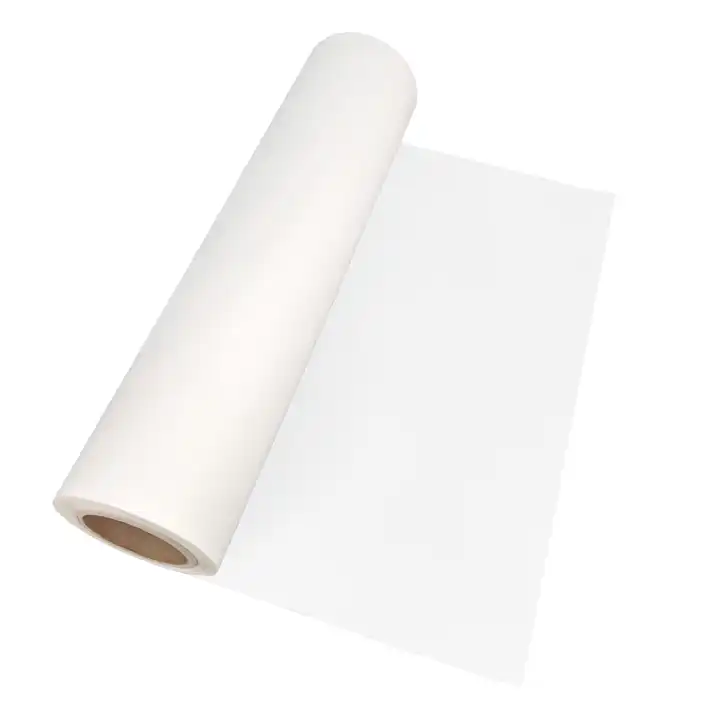
DTF heat transfer film is a substrate specially designed for white ink heat transfer printing, which uses the principle of thermal transfer to transfer patterns to fabrics or other materials. It can be said that the heat transfer film directly determines the transfer quality of white ink heat transfer.
1. What is heat transfer film?
Heat transfer film is a special PET film with a coating, which usually contains six layers: base layer, release layer, adhesive layer, printing layer, protective layer and antistatic layer, which is used in the transfer process of DTF white ink heat transfer.
From the white ink heat transfer process, we can see that the last step of the entire heat transfer process is to tear off the heat transfer film, and finally leave a pattern on the transfer. The hot tear film, cold tear film and second tear film we want to understand today are heat transfer films distinguished by different tearing times.
1.1 What is hot tear film?
Hot tear film is a PET heat transfer film that can be torn off after the hot stamping is completed before the heat transfer film cools down (usually within 10 seconds after pressing, when the ambient temperature is 35℃ or the film surface temperature is greater than 100℃), without waiting for it to cool down.
Features: Using hot tear film can save time waiting for the heat transfer film to cool down and improve the efficiency of mass production printing. However, if it is not torn off in time, the cooled glue may stick to the clothes, making it difficult to tear off, and even causing problems such as pattern residue. In general, hot tear film has strict requirements on the time, temperature, and pressure of pressing.
1.2 What is cold tear film?
Cold tear film is a PET heat transfer film that needs to wait for the film to cool down to a certain temperature (usually 30 seconds, or the film surface temperature is lower than 55°C) after the hot stamping is completed before it can be easily torn off.
Features: Cold tear film requires a certain cooling time, but the product has good stability and the color effect is matte. Cold tear film is very suitable for special fabrics (such as coated fabrics, canvas, flannel and other rough fabrics). Because after such fabrics are hot pressed, using cold tear film has enough time to restore their flatness.
1.3 What is instant tear film?
Instant tear film can actually be regarded as a supplementary form of hot tear film, a PET heat transfer film that can be torn off in a very short time (almost immediately after the pressing is completed).
Features: Due to its fast tearing characteristics, the instant tear film may be more suitable for scenarios that require high efficiency and mass production. But it has strict requirements on the tearing time and is more difficult to operate.
2. Hot tear film/cold tear film/instant tear film, which one is better?
Hot tear film, cold tear film, and instant tear film each have their own advantages and disadvantages, and are suitable for different types of production and printing needs.
Generally speaking, DTF hot tear film and instant tear film are more suitable for mass production of ordinary fabric clothing such as cotton T-shirts.
Note: Hot tear film has relatively detailed requirements for pressing time, temperature, pressure, etc. The temperature is controlled between 140-160 degrees, the pressure is adjusted to 4-5KG, and the pressing is 8-10 seconds, and it can be easily torn off.
Compared with DTF hot tear film, DTF cold tear film is more stable (the main component of cold tear film is silicon, which is easier to melt and apply than wax, the main component of hot tear film), and is suitable for finer and more complex pattern lines. The pressing temperature is recommended to be controlled at 150-170℃ for 10-20 seconds, and the film surface is cooled before tearing off.
Each DTF heat transfer film has its own advantages. You can choose the heat transfer film that suits your business according to your actual needs. After all, there is no perfect product, and the one that suits you is the best!
Special reminder: There may be slight differences between different brands and types of PET heat transfer films, so you must read the product manual carefully before use. It is recommended that you test the new product separately before shipping in bulk to ensure the final heat transfer effect.
3. How to choose high-quality heat transfer film?
High ink loading
DTF heat transfer film with inferior ink or water absorption layer may leak ink, fade or seep water during printing.
High coating quality
DTF heat transfer film has a special coating on the surface. If the coating is uneven or mixed with impurities, it will directly affect the printing effect. Therefore, it is necessary to observe whether the surface coating is uniform and delicate.
No powder sticking
After some heat transfer films are printed, there will be residual hot melt powder on the edge of the pattern, which will affect the beauty of the finished heat transfer product. Please choose a high-quality heat transfer film to ensure that the edge of the printed pattern is clean and free of residue.
Easy to peel off
High-quality DTF film can be easily torn off after pressing, ensuring the stability and integrity of the transferred pattern.
High temperature resistance
Hot melt powder will only start to melt at 80℃, so DTF heat transfer film must be resistant to high temperatures. It is recommended that you select a test temperature of 120℃. If the PET heat transfer film does not turn yellow or wrinkle, it can be judged to be of good quality.